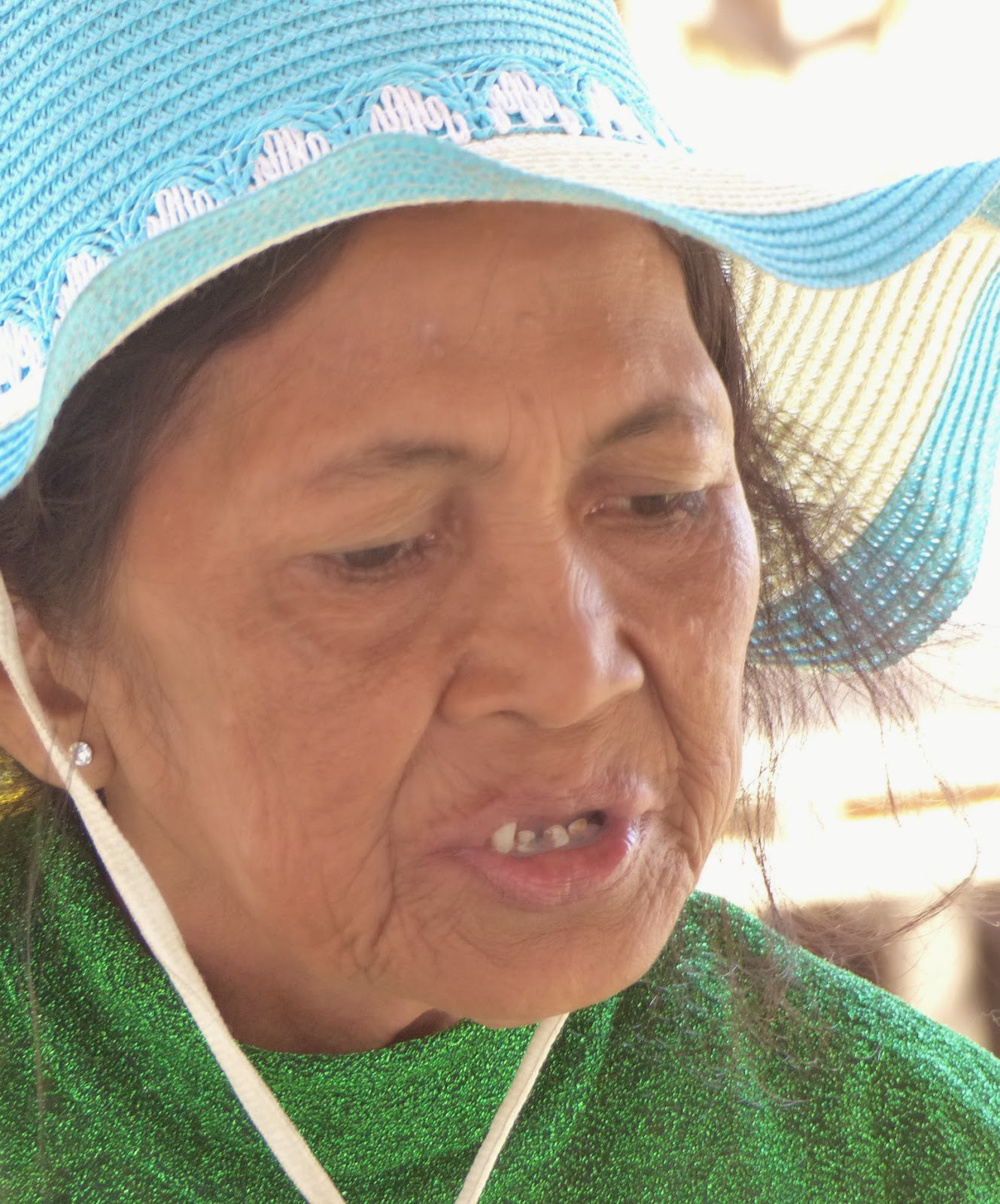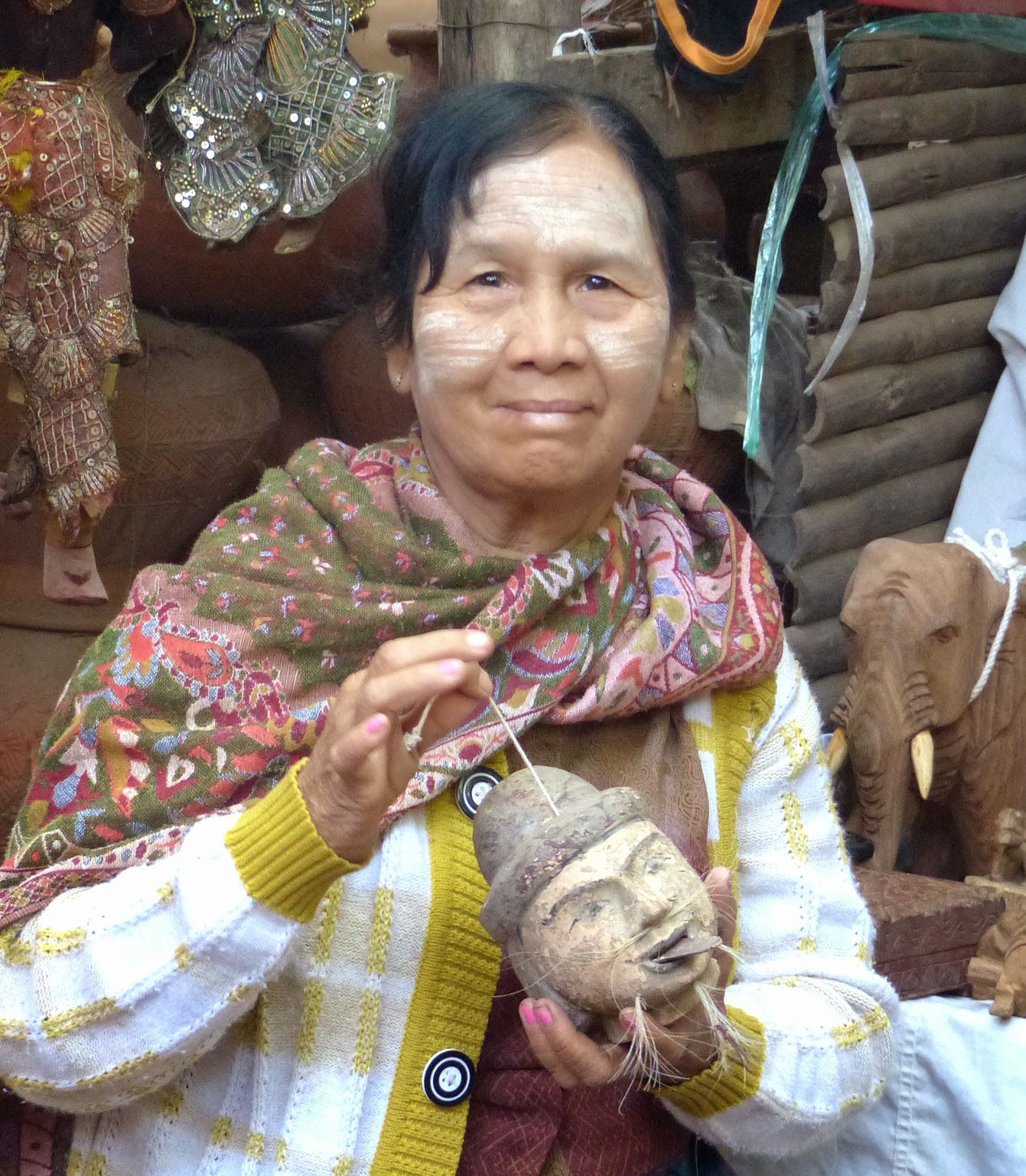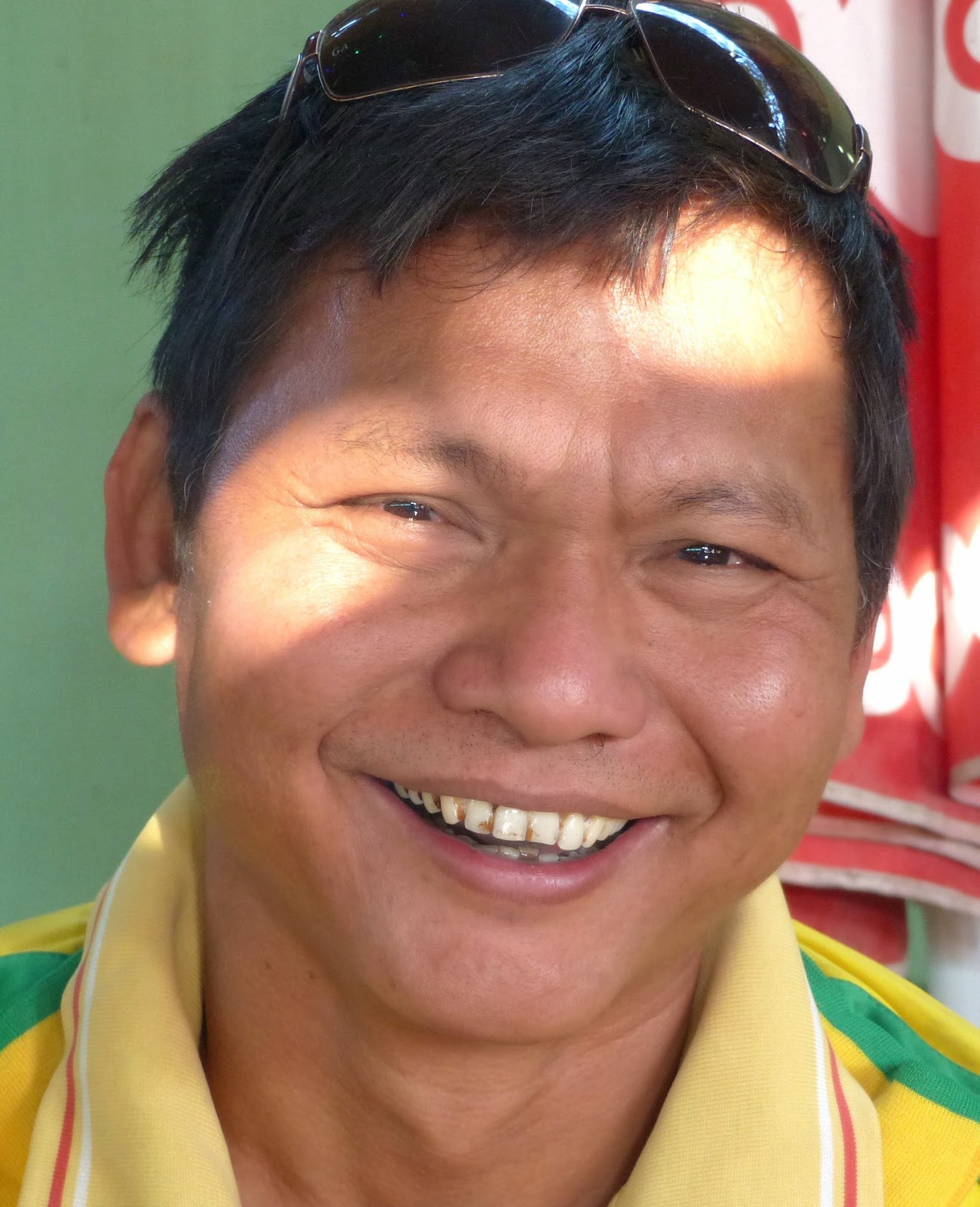The history, scenery, architecture, and art of S.E. Asia would be enough to satisfy the desires of any traveler, but I found the people as interesting, both to talk with and to look at, so I took a number of photos that I want to remember, without which no account of our travel would be complete. Some photos I took during an encounter of short or longer duration, with the consent of the subject, some I took with the advantage of the long focal length available on my Leica so that the target was unaware of my interest and was beyond my ability to ask permission─and some I just couldn't resist. The first is a mummer at Angkor Wat who charged for photos.
Next is a girl on a floating restaurant on Tonlé Sap chopping the end of a coconut so Deb could drink the milk. She seemed much too young to wield her machete so skillfully.
The children holding snakes were ferried by their mother; they demanded money to be photographed; not, I think, a lucrative endeavor even though I paid their fee, and they did not seem happy in their pursuit.
On the way to the lake, we passed fishermen and women on the shore and in the water,
and we passed children at play.
Everywhere except in Yangon, families rode small motorcycles and scooters. The law, I was told, required drivers but not passengers to wear helmets,
and limited passengers to three, a limit not always followed.
In Cambodia, motorcycles were used as towing vehicle for a wide variety of devices. Deb is buying from a motorcycle-driven ice cream side-car.
On an island in the Mekong, we ate lunch at a popular beach resort, deserted that day except for a mother washing clothes
while her son played.
The woman who brought us lunch killed, plucked, and cooked our chicken to order; it was one of the toughest birds I've ever tried to eat.
Merchants were often happy to have their photos taken. These two men were scrapping pig skin at a meat market.
The fellow selling peppers, however, did not seem happy even before I snapped his photo; perhaps he had more peppers than he could unload.
Some merchants had a lot of product, others, not so much.
The lady selling the mechanical head pulled the string and the head stuck out its tongue.
In Mandalay, we were invited into a tea house by the family running it. The father was happy to talk although he did not have much English,
the mother drank tea,
and the teenage son never lifted his eyes from his electronic game.
In Vientiane, I was sitting on steps leading down to the Mekong thinking about taking photos of the water when three women with a child walked in front of me, then saw what I was doing and tried to get out of my way. I waved that they were okay and signed to let me snap their group and the baby.
They posed, then laughed when I showed them the result.
The Hmong village offered opportunities for interesting portraits.
At the Bagan jade market, workers polished stones with foot-driven wheels.
People piled goods high on motorcycles and trucks,
but they also carried loads by hand, or head,
or shoulder.
Children wore their best for special occasions at temples.
At Mahamuni Pagoda in Mandalay, men pasted gold leaf on the Buddha to show their devotion; women (and men without gold) showed theirs by praying below the statue.
In Yangon, a young couple posed for wedding photos on the bank of Kandawgyi Lake, unaware of my camera.
Another unaware target for my camera was a thoroughly modern monk.
At the school across the river from Bagan, children were all well behaved.
This novice was not in the school─Buddhist monks run their own school for boys, free from the fees of public schools─we gave him candy too.
I took a snap of the principal.
Patrice Bleton, possessor of a marvelous collection of Tang ceramics, shows off a Khmer bronze in the doorway of his shop, "Le Pavillon de Jade," in Luang Prabang.
Tourists, unaware of my camera, take selfies with a sleeping bat in a temple in Bagan.
From the top of a Bagan temple, I saw these farmers half a mile away; the Leica brought them close.
S.E. Asia affects everyone who travels there, I think; even Ronald is changed.
Next is a girl on a floating restaurant on Tonlé Sap chopping the end of a coconut so Deb could drink the milk. She seemed much too young to wield her machete so skillfully.
The children holding snakes were ferried by their mother; they demanded money to be photographed; not, I think, a lucrative endeavor even though I paid their fee, and they did not seem happy in their pursuit.
On the way to the lake, we passed fishermen and women on the shore and in the water,
and we passed children at play.
Everywhere except in Yangon, families rode small motorcycles and scooters. The law, I was told, required drivers but not passengers to wear helmets,
and limited passengers to three, a limit not always followed.
In Cambodia, motorcycles were used as towing vehicle for a wide variety of devices. Deb is buying from a motorcycle-driven ice cream side-car.
On an island in the Mekong, we ate lunch at a popular beach resort, deserted that day except for a mother washing clothes
while her son played.
The woman who brought us lunch killed, plucked, and cooked our chicken to order; it was one of the toughest birds I've ever tried to eat.
Merchants were often happy to have their photos taken. These two men were scrapping pig skin at a meat market.
The fellow selling peppers, however, did not seem happy even before I snapped his photo; perhaps he had more peppers than he could unload.
Some merchants had a lot of product, others, not so much.
The lady selling the mechanical head pulled the string and the head stuck out its tongue.
In Mandalay, we were invited into a tea house by the family running it. The father was happy to talk although he did not have much English,
the mother drank tea,
and the teenage son never lifted his eyes from his electronic game.
In Vientiane, I was sitting on steps leading down to the Mekong thinking about taking photos of the water when three women with a child walked in front of me, then saw what I was doing and tried to get out of my way. I waved that they were okay and signed to let me snap their group and the baby.
They posed, then laughed when I showed them the result.
The Hmong village offered opportunities for interesting portraits.
At the Bagan jade market, workers polished stones with foot-driven wheels.
People piled goods high on motorcycles and trucks,
but they also carried loads by hand, or head,
or shoulder.
Children wore their best for special occasions at temples.
At Mahamuni Pagoda in Mandalay, men pasted gold leaf on the Buddha to show their devotion; women (and men without gold) showed theirs by praying below the statue.
In Yangon, a young couple posed for wedding photos on the bank of Kandawgyi Lake, unaware of my camera.
Another unaware target for my camera was a thoroughly modern monk.
At the school across the river from Bagan, children were all well behaved.
This novice was not in the school─Buddhist monks run their own school for boys, free from the fees of public schools─we gave him candy too.
I took a snap of the principal.
Patrice Bleton, possessor of a marvelous collection of Tang ceramics, shows off a Khmer bronze in the doorway of his shop, "Le Pavillon de Jade," in Luang Prabang.
Tourists, unaware of my camera, take selfies with a sleeping bat in a temple in Bagan.
From the top of a Bagan temple, I saw these farmers half a mile away; the Leica brought them close.
S.E. Asia affects everyone who travels there, I think; even Ronald is changed.














































No comments:
Post a Comment